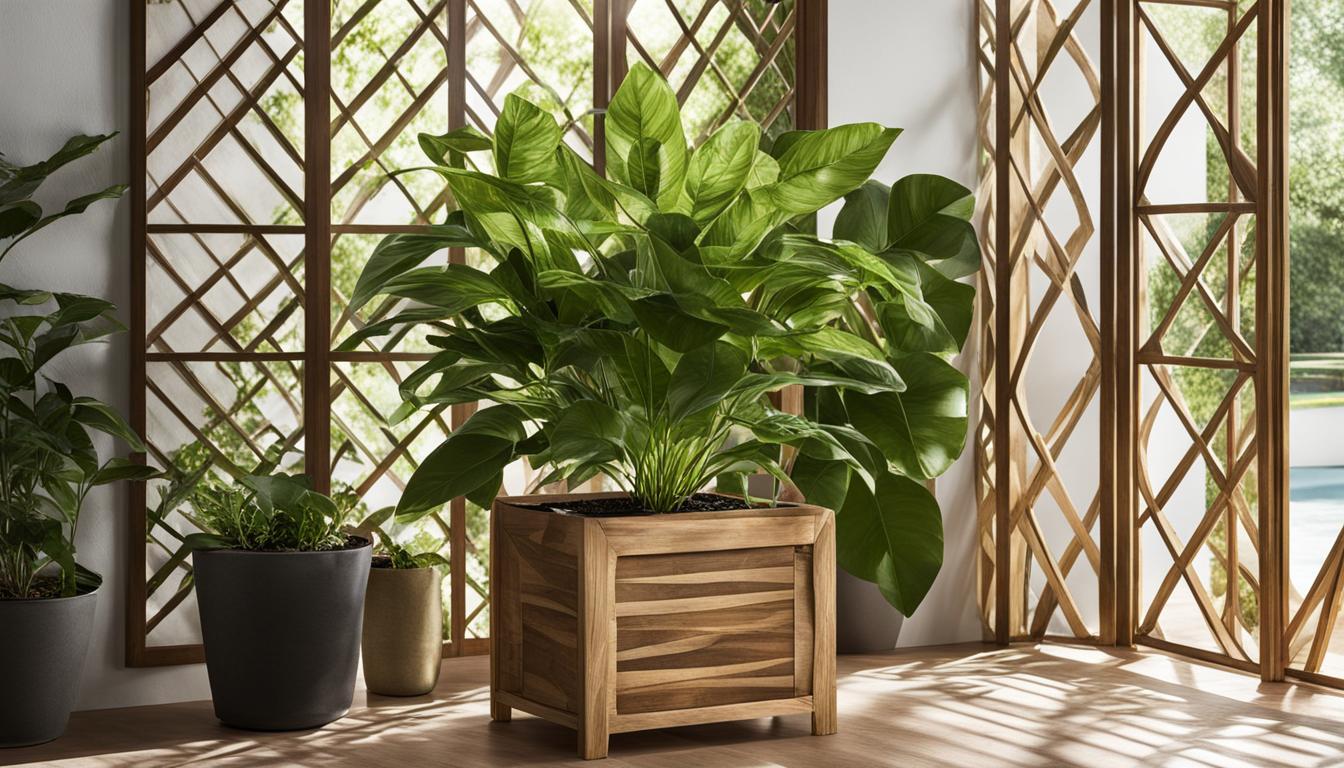
A trellis is an essential tool for indoor plant training. It provides vertical support for climbing plants, preventing them from growing in random and intrusive directions.
Using a trellis can also enhance the aesthetic appeal of your indoor garden. In their native tropical forests, many plants have evolved to climb for light. Consequently, some houseplants have a natural climbing habit that requires vertical support.
The trellis not only keeps the foliage organized but also allows you to appreciate the plant’s growth in its natural environment. When choosing a trellis, consider the material, type, and style that best suits your plant and desired aesthetic.
Select a trellis with long prongs or supports that provide good stability and sink into the soil for adequate support. Popular plants for trellising include Monstera deliciosa, Monstera adansonii, pothos, Philodendron cordatum, hoya, and ivy.
Key Takeaways:
- A trellis is a valuable tool for indoor plant training, providing vertical support and preventing random growth.
- Using a trellis enhances the aesthetic appeal of your indoor garden and allows plants to grow as they would in their natural environment.
- Consider the material, type, and style of the trellis when choosing one for your indoor plants.
- Ensure the trellis offers good stability and sinks into the soil for proper support.
- Popular indoor plants for trellising include Monstera deliciosa, Monstera adansonii, pothos, Philodendron cordatum, hoya, and ivy.
Continue reading to discover the reasons for using a trellis for indoor plants and how to choose the right trellis for your specific plant needs.
Reasons for Using a Trellis for Indoor Plants
Using a trellis for indoor plants offers several benefits that can enhance the overall appearance and growth of your plants. Here are some key reasons why incorporating a trellis into your indoor gardening setup can be advantageous:
- Vertical Support: One of the main benefits of using a trellis is that it provides vertical support for your plants. By allowing them to grow upward, a trellis helps create an aesthetically pleasing display and prevents the foliage from growing in random and intrusive directions.
- Organized Growth: A trellis helps keep your plant’s foliage organized, preventing it from tangling and becoming messy. This makes it easier to maintain and care for your plants, as well as enhance the overall visual appeal of your indoor garden.
- Improved Visibility: When you use a trellis, the beautiful foliage of your indoor plants is brought up to eye level, allowing you to better appreciate its color, texture, and intricate details. This can significantly enhance your enjoyment of your plants and make them a focal point in your space.
- Natural Growth Environment: Using a trellis allows your plants to grow in a way that mimics their natural environment. Many plants in their native habitats have evolved to climb for light, and a trellis provides the necessary vertical support that encourages healthy growth.
- Creative Element: A trellis can serve as a unique vertical sculpture in your home, adding a touch of creativity and personalization to your indoor garden. You can choose trellises of different materials, styles, and designs to match your aesthetic preferences and create a visually appealing space.
By using a trellis for your indoor plants, you can enjoy these benefits and create a stunning display of vertical growth in your indoor garden. Whether you have climbing plants like Monstera deliciosa or trailing plants like pothos, a trellis can provide the necessary support and organization for their growth. Consider incorporating a trellis into your indoor gardening routine and reap the rewards of a beautifully trained and flourishing plant collection.
Choosing the Right Trellis for Your Indoor Plants
When it comes to selecting a trellis for your indoor plants, it’s important to consider the specific requirements of your plants and your desired aesthetic.
The right trellis can provide the necessary support for your plants to grow upward and create a visually appealing display. Here are some tips to help you choose the perfect trellis for your indoor plants:
Material:
Consider the material of the trellis, as it can impact the overall look and durability. Popular materials include wood, metal, and bamboo.
Wood trellises can add a natural and rustic charm to your indoor garden, while metal trellises offer a more modern and sleek look. Bamboo trellises are eco-friendly and blend well with a tropical or bohemian style.
Type:
There are various types of trellises to choose from, including wall-mounted trellises, freestanding trellises, and obelisk trellises. Wall-mounted trellises are great for small spaces and can be attached to walls or placed against them.
Freestanding trellises can be placed anywhere in your indoor garden and provide flexibility for plant placement. Obelisk trellises are pyramid-shaped and can be a beautiful focal point in your space.
Style:
The style of the trellis can enhance the overall aesthetic of your indoor garden. Choose a style that complements your interior decor and the overall theme of your space.
From simple and minimalistic designs to intricate and decorative patterns, there are trellises available in a wide range of styles to suit your personal taste.
By considering the material, type, and style of the trellis, you can choose the perfect support structure for your indoor plants. Remember to also ensure that the trellis has long prongs or supports that can sink deep into the soil for stability.
Taking the time to choose the right trellis will not only provide support for your plants but also add beauty and charm to your indoor garden.
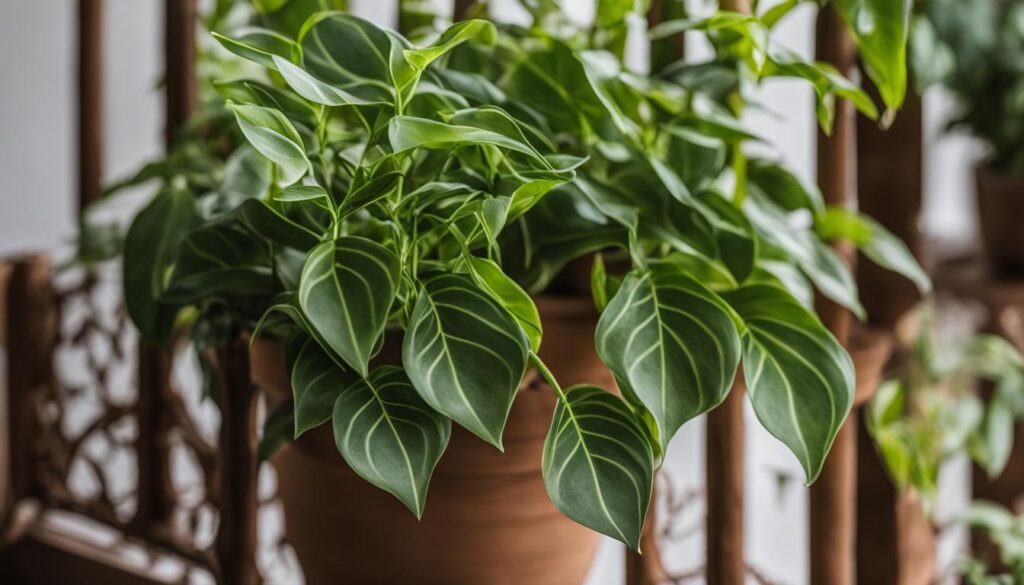
Getting Started with Indoor Plant Training
To begin training your indoor plants with a trellis, you’ll need a few essential steps. Firstly, make sure you have a potted plant that is suitable for trellising.
If the plant is still in a plastic grow pot, consider repotting it into a slightly larger container to allow for root growth and stability for the trellis. If the plant is already established in a pot, you can directly add the trellis without repotting.
Before attaching the trellis, gently untangle the vining foliage and separate each stem for easier attachment. Place the trellis in the pot, either in the middle or slightly to the back, depending on your desired aesthetic and the plant’s shape. Secure the trellis by pushing the supporting legs or prongs into the soil.
Now it’s time to guide each stem of the plant onto the trellis. Use the natural direction of growth as a guide, gently lifting each stem and guiding it onto the structure. For plants that need extra support, you can gently attach the stems to the trellis using fishing line, plant ties, or mini clips.
Step-by-Step Guide for Getting Started with Indoor Plant Training:
- Choose a suitable potted plant for trellising
- If necessary, repot the plant into a larger container
- Untangle the vining foliage and separate each stem
- Place the trellis in the pot and secure it in the soil
- Guide each stem onto the trellis, using the natural direction of growth
- For additional support, use fishing line, plant ties, or mini clips
Remember, different plants may require different training techniques, so be sure to research specific instructions for your plant’s needs. With a little practice and patience, you’ll have beautifully trellised indoor plants that add a touch of elegance and vertical interest to your indoor garden.
Caring for Trellised Indoor Plants
Once you have trellised your indoor plants, it’s important to provide them with the care they need to thrive. Proper care will help your plants grow vigorously and maintain their beautiful appearance. Here are some essential tips to keep in mind:
Light and Moisture
Ensure that your trellised plants receive the appropriate amount of light for their specific requirements. With the foliage reaching higher, they may require more direct sunlight or bright, indirect light. Monitor their light exposure and adjust their placement accordingly.
With the foliage growing vertically and finding more light, these plants may require more frequent watering. Keep an eye on the soil moisture and water them as needed to prevent dryness.
Fertilization
To promote healthy growth and encourage your trellised plants to climb more vigorously, regular fertilization is essential. Use a balanced, water-soluble fertilizer according to the instructions on the packaging.
During the growing season, apply the fertilizer at the recommended frequency to provide your plants with the necessary nutrients. This will help them produce new foliage and thrive on their trellises.
Pruning and Pest Control
Regular pruning is crucial to maintain the shape and appearance of trellised indoor plants. Trim any damaged, yellowing, or overgrown foliage to keep your plants looking neat and healthy.
Keep an eye out for pests such as aphids, mealybugs, or spider mites. If you notice any signs of infestation, promptly treat your plants with appropriate organic or chemical pest control methods to prevent further damage.
Summary
Trellised indoor plants require proper care to thrive and reach their full potential. Provide them with the right amount of light and moisture, fertilize them regularly, and maintain them through pruning and pest control.
With these care tips in mind, your trellised plants will continue to grow beautifully on their supports, creating a stunning display in your indoor garden.
Trellis Techniques for Indoor Plant Training
Training indoor plants with a trellis requires different techniques depending on the type of plant you are working with. Some plants, such as Monstera deliciosa and pothos, have natural climbing habits and will readily attach themselves to a trellis.
For these plants, simply guide their stems onto the trellis, following the natural curve of their growth. You can gently secure the branches in place using fishing line, plant ties, or mini clips if needed.
Other plants, like hoya and ivy, may need a little more assistance when it comes to trellising. These plants have vining or draping growth habits and may not readily attach themselves to a trellis.
In these cases, you can gently lift the stems and guide them onto the trellis, encouraging them to wrap around the structure. Using fishing line or plant ties, secure the stems to the trellis to help them stay in place and provide support.
When training your indoor vines with a trellis, it’s important to regularly check on their progress and adjust as needed. As the plant grows, you may need to guide new growth onto the trellis and prune away any unruly branches.
Keep an eye out for any signs of stress or damage, such as wilting or yellowing leaves, and address the issue promptly.
Remember, each plant is unique, so it’s essential to understand your specific plant’s growth habits and requirements. By using the right trellis techniques and providing proper support, you can help your indoor vines thrive and create a stunning green display in your home.
Trailing Houseplants and Their Growth Habits
Trailing houseplants are a popular choice for indoor gardening enthusiasts, as they bring a touch of nature indoors while adding a unique aesthetic appeal.
These plants have a natural trailing or vining growth habit, making them ideal candidates for training with trellises. Understanding the growth habits of trailing houseplants is essential for successfully trellising and supporting these beautiful green companions.
Vining House Plant Growth Habits
Trailing houseplants, such as pothos, philodendrons, and hoyas, exhibit various growth habits that determine how they interact with trellises and other support structures. Some plants, like pothos, have long, cascading vines that can be trained to climb trellises or trail along walls.
Philodendrons, on the other hand, have aerial roots that naturally cling to rough-textured surfaces like moss poles or ropes. Hoyas, known for their waxy leaves and beautiful colored flowers, can also be trained to climb, but certain varieties are better suited for trailing.
When trellising trailing houseplants, it’s important to consider their growth habits and choose the most suitable support structure. For plants with long vines, a trellis with horizontal bars or wires can provide ample room for growth and create an eye-catching display.
Those with aerial roots may benefit from a moss pole or a rough-textured support that mimics their natural environment. By aligning the trellis with the plant’s growth habit, you can encourage healthy growth and create a visually stunning indoor garden.
| Trailing Houseplant | Growth Habit | Recommended Support Structure |
|---|---|---|
| Pothos | Long, cascading vines | Trellis with horizontal bars or wires |
| Philodendron | Aerial roots that cling to rough-textured surfaces | Moss pole or rough-textured support |
| Hoya | Varies by variety; some are better suited for trailing | Depends on specific hoya variety |
With a clear understanding of the growth habits and support needs of trailing houseplants, you can confidently select the right trellis or support structure to ensure their healthy growth and add a beautiful touch to your indoor space.
Trailing Plant Training Tips
When it comes to training trailing plants, there are a few key tips and techniques to keep in mind. Whether you’re using a moss pole or creating your own DIY trellis, these tips will help you support and guide your plants for optimal growth and aesthetics.
Moss Pole Trellis
A moss pole is a popular and effective method for training trailing plants such as Monsteras, Philodendrons, and Pothos. To create a moss pole, you’ll need a wooden dowel, sphagnum moss, and twine.
Measure the depth of your pot and mark the bare section of the pole accordingly. Securely attach twine around the mark and tightly wrap it around the pole, adding moss as you go.
Repeat this process, gradually filling the pole with moss and securing it with twine. The moss pole provides a central supporting structure, allowing your plant to climb and grow vertically.
DIY Trellis
If you prefer a more customizable option, you can create your own trellis using thin wire or zip ties and bamboo stakes. Lay two bamboo poles flat on the ground at your desired width and attach them together using zip ties or galvanized wire.
Cut a third bamboo pole into suitable lengths for the horizontal sections and attach them to the vertical poles. Plant the trellis in your pot, gently guiding your plant up and into the support frame.
A DIY trellis allows you to design a structure that fits your specific needs and provides optimal support for your trailing plants.
Whether you choose a moss pole or a DIY trellis, these support structures will help your trailing plants grow upward and create an attractive display.
Remember to regularly monitor your plants’ growth and adjust the trellis or support as needed. With proper training and care, your trailing plants will thrive and add beauty to your indoor garden.
Step-by-Step Guide for Building a Moss Pole and DIY Trellis
If you’re looking to provide optimal support and training structure for your trailing plants, building a moss pole or a DIY trellis can be a great option. Let’s explore the step-by-step process for creating these support systems.
Building a Moss Pole
To build a moss pole, you will need a wooden dowel, sphagnum moss, and twine. Begin by measuring the depth of the pot and marking the bare section of the pole accordingly.
Tie twine around the mark and wrap it tightly around the pole, adding sphagnum moss as you go. Repeat this process, gradually filling the pole with moss and securing it with twine. The moss will provide a natural support for your trailing plants to climb and thrive.
Creating a DIY Trellis
If you prefer a more customizable option, you can create a DIY trellis using thin wire or zip ties and bamboo stakes. Start by laying two bamboo poles flat on the ground at the desired width and attach them together using zip ties or galvanized wire.
Cut a third bamboo pole into suitable lengths for the horizontal sections and attach them to the vertical poles. Once your DIY trellis is assembled, you can plant it in your pot and gently guide your trailing plant up and into the support frame.
Both moss poles and DIY trellises provide stability and structure for your trailing plants while adding an aesthetic touch to your indoor garden.
Choose the option that suits your preferences and the needs of your specific plants. Remember to secure the trellis or pole in the pot firmly, ensuring the safety and support of your plants as they grow and climb.
Moss Pole vs. DIY Trellis Comparison
| Factors | Moss Pole | DIY Trellis |
|---|---|---|
| Materials | Wooden dowel, sphagnum moss, twine | Bamboo stakes, thin wire or zip ties |
| Customizability | Less customizable | Highly customizable |
| Support | Natural support provided by moss | Structured framework for plants to climb |
| Aesthetic Appeal | Natural and rustic | Can be personalized and creative |
| Installation | Sink into the pot’s soil | Secure in the pot with zip ties or wire |
Expert Advice for Trailing Plant Training and Support
When it comes to trailing plant training and support, seeking expert advice can make all the difference. Professionals at your local garden center or greenhouse are well-versed in the intricacies of indoor gardening and can provide invaluable guidance tailored to your plant’s specific needs.
Whether you need assistance in selecting the right trellis for your trailing plant or advice on different training techniques, these experts have the knowledge and experience to help you succeed. They can recommend the most suitable support structures and provide tips on general care for trellised indoor plants.
By consulting with these professionals, you can ensure that your trailing plants receive the optimal support they need to thrive. Their expertise will help you create a visually appealing and well-organized indoor garden, bringing out the best in your trellised plants.
FAQ
What is the purpose of using a trellis for indoor plants?
A trellis provides vertical support for climbing plants, preventing them from growing in random directions and enhancing the aesthetic appeal of your indoor garden.
Which plants are suitable for trellising indoors?
Popular plants for trellising include Monstera deliciosa, Monstera adansonii, pothos, Philodendron cordatum, hoya, and ivy.
How does using a trellis benefit indoor plants?
Using a trellis provides vertical support, keeps foliage organized, allows better appreciation of plant growth, and mimics the plant’s natural environment.
What should I consider when choosing a trellis for my indoor plants?
Consider the material, type, and style that best suits your plant and desired aesthetic. Select a trellis with long prongs or supports for stability and adequate support.
How do I train indoor plants using a trellis?
Start with a potted plant, untangle the foliage, place the trellis in the pot, secure it in the soil, and guide each stem of the plant onto the trellis using the natural direction of growth.
How do I care for trellised indoor plants?
Ensure the appropriate amount of light and moisture, adjust watering schedule as needed, apply regular fertilizer during the growing season, and perform regular pruning and pest/disease monitoring.
What are the vine training techniques for different indoor plants?
Gently lift each stem and guide it onto the trellis, use fishing line, plant ties, or clips for extra support, and allow room for stems to grow.
Which trailing houseplants can be trained using trellises?
Trailing houseplants such as pothos, hoyas, philodendrons, and monsteras can be trained using trellises or other support structures.
How do I build a moss pole for trailing plants?
Use a wooden dowel, sphagnum moss, and twine to gradually fill the pole with moss, securing it tightly with twine.
How can I create a DIY trellis for my trailing plants?
Use thin wire or zip ties and bamboo stakes to create a trellis structure, attaching the horizontal sections to the vertical poles.
Where can I seek expert advice for trailing plant training and support?
Consult experts at your local garden center or greenhouse for specific guidance on trellised plants and support structures.

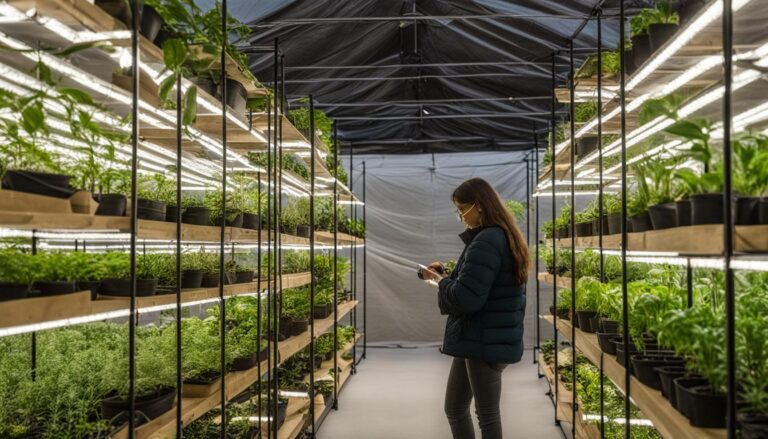
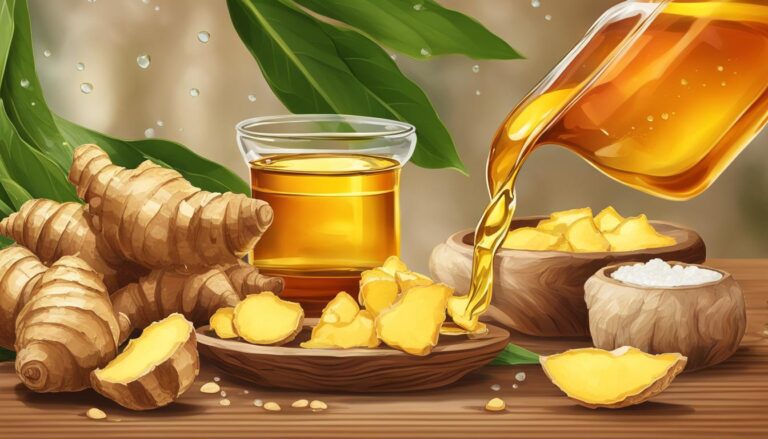
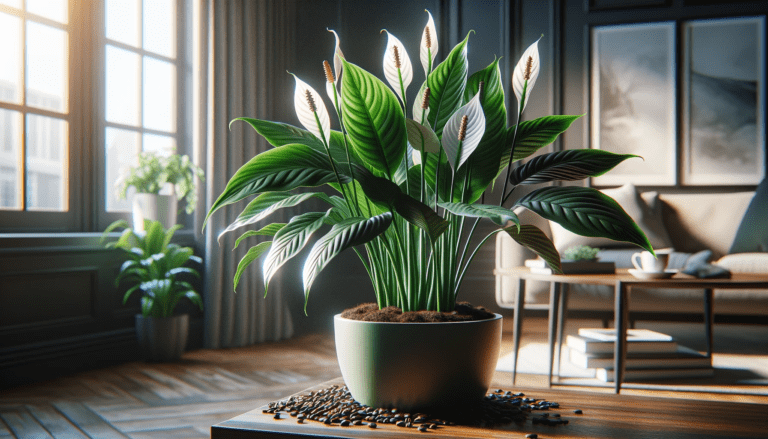
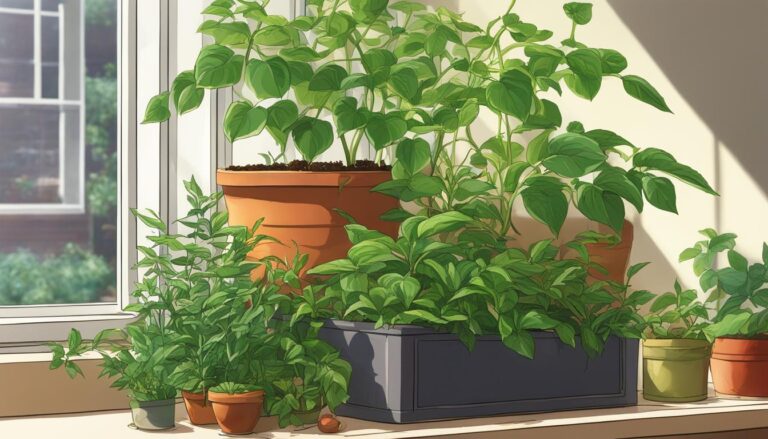
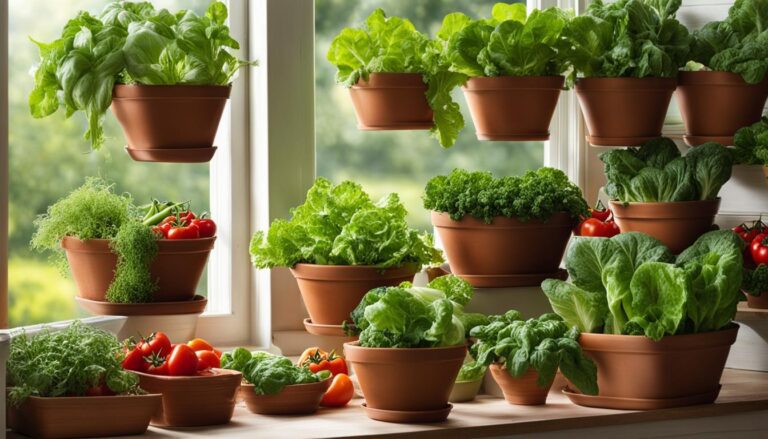
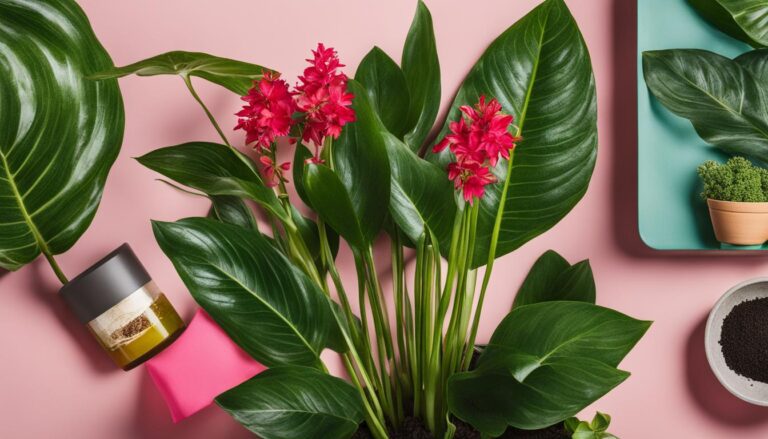
2 Comments
Comments are closed.